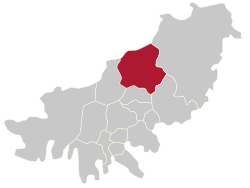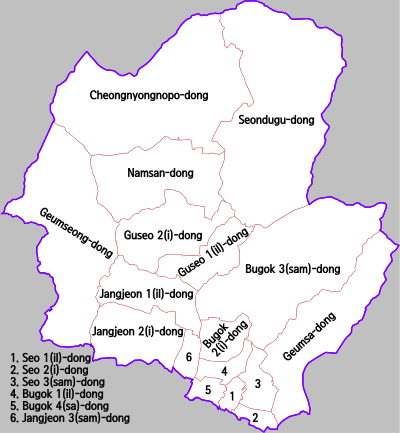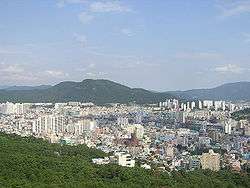Geumjeong District
| Geumjeong 금정구 | ||
|---|---|---|
| Autonomous District | ||
| Korean transcription(s) | ||
| • Hanja | 金井區 | |
| • Revised Romanization | Geumjeong-gu | |
| • McCune-Reischauer | Kŭmjŏng-ku | |
|
View of Geumjeong-gu from Geumjeongsan | ||
| ||
 | ||
| Country | South Korea | |
| Region | Yeongnam | |
| Provincial level | Busan | |
| Administrative divisions | 20 administrative dong | |
| Area | ||
| • Total | 65.19 km2 (25.17 sq mi) | |
| Population (2017[1]) | ||
| • Total | 243,293 | |
| • Density | 3,732/km2 (9,670/sq mi) | |
| • Dialect | Gyeongsang | |
| Website | Geumjeong District Office | |
Geumjeong District is a district in north central Busan, South Korea. Approximately 7.3% of Busan's population is in Geumjeong-gu.[2]
The Hoedong Reservoir is located on the district's eastern boundary, and the mountain Geumjeongsan on the west. Because of this, 75% of the district's land is restricted from residential development. The district's population is concentrated in the valley of the Oncheoncheon stream, a tributary of the Suyeonggang.
Notable landmarks include Beomeosa, a Buddhist temple dating to the Silla dynasty, and Geumjeongsan, the mountain which overlooks much of the district. Geumjeongsan is topped by the walls of the Geumjeongsanseong, which were built in the Joseon Dynasty.
Several colleges and universities are located in Geumjeong-gu. The most prominent of these is Pusan National University.
Geumjeong-gu serves as a nexus of transit connections between central Busan and the rest of Korea. The northern end of Busan Subway Line 1 lies in Nopo-dong, where it adjoins Busan's major express bus terminal. In addition, the southern terminus of the Gyeongbu Expressway lies within the district.
History
For most of its history, Geumjeong was officially part of Dongnae, which was itself an independent region until it was amalgamated into the city of Busan in 1942. Geumjeong-gu was formed by separation from Dongnae in 1988.
Originally Geumjeong consisted of 20 administrative dong, but several changes have been made to leave the current total at 17:[3]
- 1992
- Bugok-4-dong was created from Bugok-1-dong
- 1998
- Oryun-dong was absorbed by Bugok-3-dong
- Seon-dong and Dugu-dong were merged to form Seondugu-dong
- Nopo-dong and Cheongnyeong-dong were merged to form Cheongnyeongnopo-dong
- 2009
- Seo-4-dong was absorbed by Seo-3-dong
Administrative divisions
Geumjeong-gu is divided into 9 legal dong, which altogether comprise 17 administrative dong, as follows:[4]

| Key | Administrative dong | Hangeul | Hanja | Area | Households | Inhabitants | Density |
|---|---|---|---|---|---|---|---|
| 행정동 | 한글 | 한자 | ㎢ | 세대 (2012) | 명 (2012) | pop/㎢ | |
| 1 | Seo-1-dong | 서제1동 | 書第1洞 | 0.36 | 4,484 | 9,806 | 27,239 |
| 2 | Seo-2-dong | 서제2동 | 書第2洞 | 0.40 | 5,861 | 13,897 | 34,743 |
| 3 | Seo-3-dong | 서제3동 | 書第3洞 | 0.92 | 5,864 | 14,350 | 15,598 |
| 4 | Geumsa-dong | 금사동 | 錦絲洞 | 5.52 | 4,376 | 10,660 | 1,931 |
| 5 | Bugok-1-dong | 부곡제1동 | 釜谷第1洞 | 0.71 | 4,834 | 11,600 | 16,338 |
| 6 | Bugok-2-dong | 부곡제2동 | 釜谷第2洞 | 1.20 | 6,812 | 18,868 | 15,723 |
| 7 | Bugok-3-dong | 부곡제3동 | 釜谷第3洞 | 8.16 | 6,525 | 18,490 | 2,266 |
| 8 | Bugok-4-dong | 부곡제4동 | 釜谷第4洞 | 0.67 | 6,360 | 16,310 | 24,343 |
| 9 | Jangjeon-1-dong | 장전제1동 | 長箭第1洞 | 3.27 | 6,754 | 15,995 | 4,891 |
| 10 | Jangjeon-2-dong | 장전제2동 | 長箭第2洞 | 2.06 | 3,837 | 11,298 | 5,484 |
| 11 | Jangjeon-3-dong | 장전제3동 | 長箭第3洞 | 0.68 | 3,868 | 8,730 | 12,838 |
| 12 | Seondugu-dong | 선두구동 | 仙杜邱洞 | 12.05 | 1,286 | 2,857 | 237 |
| 13 | Cheongnyeongnopo-dong | 청룡노포동 | 靑龍老圃洞 | 10.91 | 3,959 | 10,192 | 934 |
| 14 | Namsan-dong | 남산동 | 南山洞 | 3.64 | 13,191 | 35,255 | 9,685 |
| 15 | Guseo-1-dong | 구서제1동 | 久瑞第1洞 | 3.05 | 7,071 | 20,168 | 6,612 |
| 16 | Guseo-2-dong | 구서제2동 | 久瑞第2洞 | 3.19 | 12,432 | 37,403 | 11,725 |
| 17 | Geumseong-dong | 금성동 | 金城洞 | 8.41 | 491 | 1,211 | 144 |
| Geumjeong-gu | 금정구 | 金井區 | 65.20 | 98,005 | 257,090 | 3,943 | |
Sister cities
See also
References
- ↑ http://rcps.egov.go.kr:8081/jsp/stat/ppl_stat_jf.jsp
- ↑ Population Status of Geumjeong-gu
- ↑ About Geumjeong: History
- ↑ 《제24회 금정구 통계연보》. 금정구청. 2012. 63쪽, 74쪽.
External links
| Wikimedia Commons has media related to Geumjeong-gu, Busan. |
- Geumjeong-gu website (in English)
Coordinates: 35°14′30″N 129°05′30″E / 35.24167°N 129.09167°E

